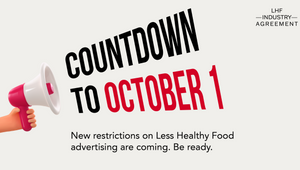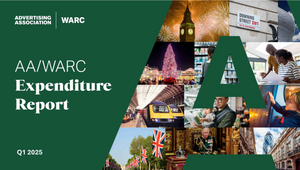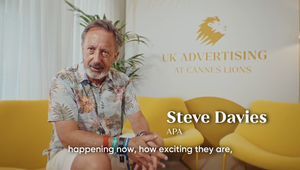
Beyond the Headlines of the Advertising Association and WARC’s Expenditure Report

The latest quarterly data from the Advertising Association and WARC’s Expenditure Report was dominated by optimism. It showed UK ad spend rose 9.7% to £10.6 billion during the third quarter of 2024 – the first time ad spend has exceeded the £10bn barrier in Q3, largely attributed to improved performance for search and robust growth for other online formats. The UK advertising market is also forecast to have grown by 11.2% overall in 2024, an upgrade of 0.6 percentage points (pp) from the October forecast, with full year spend expected to reach £40.7 billion.
But when you get into the details of the report, what are the subplots? To zoom in, LBB’s Alex Reeves checked in with Alex Brownsell, head of content at WARC Media.
LBB> What stands out to you in the AA/WARC Expenditure Report data? Are there things you find particularly interesting that we can explore in more detail?
Alex> There’s a lot to unpack beyond the headline figures.
On the surface, the numbers sound incredible – an 11% growth forecast for last year. I think that’s the highest in 25 years, unless you count the covid anomaly, when there was a massive year-on-year spike following the drop in 2020.
But when you look deeper into the details, it’s a different story. TV is down. Publishing is down. Cinema is way down. Most sectors are actually spending less than they did before.
It really highlights what we’ve talked about before – the ‘two-speed ad economy’. You’ve got the big tech players, specifically in search and social media, driving massive GDP-busting growth. Social media was up 18.9%. Search was up 12.6% in the last reported quarter.
What this shows is that those platforms have found a way to expand the advertising market. When we talk about ad spend increasing, it’s not necessarily the same players from 20 years ago simply spending more. It’s not just Coca-Cola, Unilever, or P&G increasing their budgets. Instead, big tech has opened up advertising to a whole new tranche of advertisers – SMEs, digital-first brands, and newer businesses that wouldn’t have followed traditional ad spend patterns.
Twenty years ago, brands might have grown via word of mouth, then progressed to print, out-of-home, and TV advertising. That’s still happening in some cases, but the majority of these newer advertisers are staying focused on big tech – the very platforms that helped them grow in the first place. So big tech hasn’t just expanded the horizons of the ad industry; it’s also keeping that growth contained within its own ecosystem as much as possible.
At WARC, we argue strongly that these companies will eventually hit a ceiling if they rely solely on performance advertising. You need brand-building campaigns to generate future demand.
We recently released a report called The Multiplier Effect, where we explore how brand and performance advertising can reinforce each other – it’s not an either-or situation. But a lot of advertisers, particularly those that have emerged in the last 10-15 years, are stuck in a cycle of dependency on Meta, Google, YouTube, and increasingly Amazon.
That definitely feels like one of the big trends in the data – it’s a real head-scratcher. You see that top-line growth figure, and then you realise that most channels are either flat or down.
LBB> Are there any revelations that buck that general trend?
Alex> In the UK, radio is an outlier – especially when you compare it to global trends.
In the US, commercial radio – barring a brief period around 2021 – has been in decline for nearly 20 years. That’s a pattern we see in most markets. Broadcast radio is generally in structural decline. But the UK is an exception. The commercial radio market here is incredibly strong, and it keeps growing. RAJAR data shows that consumption is actually increasing. So in this case, ad spend is following audience behaviour. That’s a positive sign – it means advertisers are responding to where people are actually spending their time.
It also highlights how well UK commercial radio has adapted to changing trends. We’ve seen a massive proliferation of niche stations catering to specific decades, sub-genres, or listener preferences. In a way, commercial radio has learned from streaming platforms, tailoring its offering to match what people want to hear.
Of course, I’d need to look into this further, but I’d expect the audience to skew older. Even so, right now, it remains a strong commercial proposition.
For brands, this is great – radio delivers quality reach.
And if you work in production, it’s even more interesting. Radio advertising requires creativity. It’s not just cheap, dynamically generated display advertising. Sure, there’s some automation creeping into audio ad production, but it still demands more creative attention than something like social or search advertising.
That’s an interesting story in itself.
LBB> What other media are interesting to look at?
Alex> I think out of home is worth looking at as well. Since bottoming out in 2020, it’s been steadily climbing.
It’s partly a reflection of people returning to offices. More and more companies are mandating employees back to work, which naturally boosts inner-city and commuter-belt out-of-home advertising.
But I think there’s another factor at play – it’s harder now to achieve mass reach through traditional means. TV used to be the primary way brands built reach, but that’s changed. The IPA published figures in their TouchPoints survey last year showing that out-of-home is now the number one reach medium in the UK – it’s overtaken broadcast television.
I remember seeing that stat at the time and not really clocking it. Then Les Binet mentioned it on the Uncensored CMO podcast, and everyone suddenly went, ‘Oh, wow.’ Credit to Les for flagging it.
But it makes sense – especially for reaching the 16-34 demographic, who are harder to hit through TV. Out of home is filling that gap, particularly now that more people are heading back into cities and commuter areas for work.
Another thing with out of home is that people are increasingly seeing its role in earned media. There’s been some research on this that shows that out-of-home can drive a lot of organic sharing. A lot of outdoor campaigns tend to get widely shared. Of course, some of them are fake, like that ‘eyelashes on the Tube tunnel’ stunt. But plenty of real out-of-home campaigns generate huge online traction.
That adds a layer of ambition. Even if a brand only buys one or two sites, if they go all-in with something really creative and interesting, they can get a lot of social media traction off the back of it.
LBB> At the start of this conversation, we talked about how most of the growth has been concentrated in performance-based advertising – spaces where it’s harder to build a brand in a traditional sense. Out of home provides part of the answer to that, but where else is brand building happening?
Alex> There are still the traditional ways – linear broadcast TV can still deliver a decent amount of reach. You can top that up with print, and out-of-home plays a role as well.
But I think most brands are now looking to places like BVOD (broadcaster video on demand) for high-quality, audio-visual brand building. That’s growing pretty quickly – BVOD was up nearly 9% in the last quarter and 12.4% year-on-year.
Another big story is ad-funded streaming. Amazon really turned the industry onto SVOD advertising, but Netflix’s ad-supported proposition is growing a lot faster than most people expected.
All of this adds to the fragmentation and complexity of media planning today. You need a multifaceted plan to build reach across different channels.
And then, of course, platforms like YouTube and TikTok are increasingly being used for brand building. But that comes with challenges. First, it’s harder to measure and connect everything together to get a full picture of your reach. Second, there’s the contextual element – brand safety issues, knowing what your ad is appearing before or after. That makes things more complicated.
LBB> One thing we haven’t touched on yet is categories in terms of spend. The two that came out on top were financial services and consumables. Why do you think that is?
Alex> For companies in those consumables categories – Unilever, P&G, Mars, and the like – there’s a stronger focus on reach and maintaining mental availability. A lot of marketing effectiveness methodologies from the past decade – Byron Sharp’s ‘How Brands Grow’, for example – have seeped into those categories, particularly FMCG and household goods. That could explain why we’re seeing continued growth in ad spend there.
Financial services? I’m not entirely sure what’s driving that. But going back to my earlier point, one thing these reports don’t always capture is how much spend is coming from emerging areas of the market – newer brands that don’t quite fit into traditional category definitions. The way we categorise spend might not fully reflect what’s happening.
LBB> That’s an interesting thought. I wonder if part of the financial services ad spend is coming from crypto, fintech, and other newer financial players?
Alex> Yeah, that’s a good point. You’ve got all the neo-banks as well. They’ve had a bumpy time lately, but they still need to stay on the front foot with advertising.
Categories like financial services and automotive have a built-in need to be always on in their marketing. If you’re a seasonal brand, you can time your advertising around key moments. But with financial services, you never know when someone will be in the market for a mortgage.
The same with automotive – you don’t know when someone will be looking to buy a car. So those brands have to keep topping up their mental availability year-round. That could be part of the explanation too.
LBB> There’s another way to look at these figures – when ad spend is lower in certain media, it can actually present an opportunity. If there’s less competition in a particular channel, and a brand can make the best use of that medium, it could be a strategic advantage. Are there any media channels that you think are being undervalued by brands at the moment?
Alex> I think there are definitely opportunities in what you might call ‘traditional’ parts of the media ecosystem. There are still high levels of consumption in these spaces, whether that’s TV in all its various forms or audio, including radio and podcasts.
There’s headroom for brands to use these channels more effectively. And we know they work – all the research shows that high-attention formats drive impact.
If you’re a brand spending a lot of money bidding against your own name in PPC (pay-per-click) advertising, there are plenty of case studies showing what happens when you stop doing that and redirect spend into brand-building efforts elsewhere. And it goes really well. Airbnb is a really good example. Nike fairly famously as well.
For marketers, there’s always an opportunity to capture share of voice, and we know that Share of Voice is a key driver of both category growth and brand growth.
So yes, I do think there’s headroom in some of these traditional media channels – ones that brands might not be investing in as much right now, but which still deliver strong results.
LBB> A lot of these trends probably play out in similar ways across most comparable markets. But radio, for example, seems to have a particular uptick in the UK. Is there anything else in this report that stands out as a uniquely British trend?
Alex> Broadly, the UK follows most global advertising trends. But one area where we differ is TV advertising – the UK’s TV ad market has been more resilient than many other countries, particularly in linear broadcast television.
In the US, that market is imploding. Over there, connected TV (CTV) is approaching an inflection point, and traditional broadcast TV is in sharp decline. We’re miles away from that here. The UK’s broadcast TV market is still performing relatively well compared to other markets.















